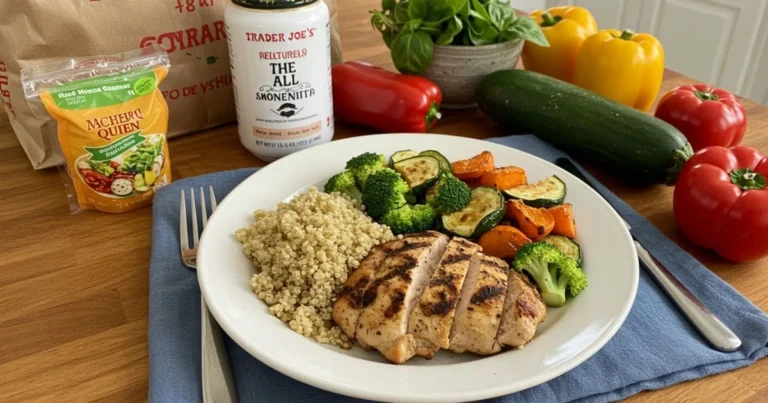Imagine adding a burst of flavor and heat to your favorite dishes with Thai chili. This versatile pepper is key in many Asian cuisines. It can make any recipe better, from traditional to modern.
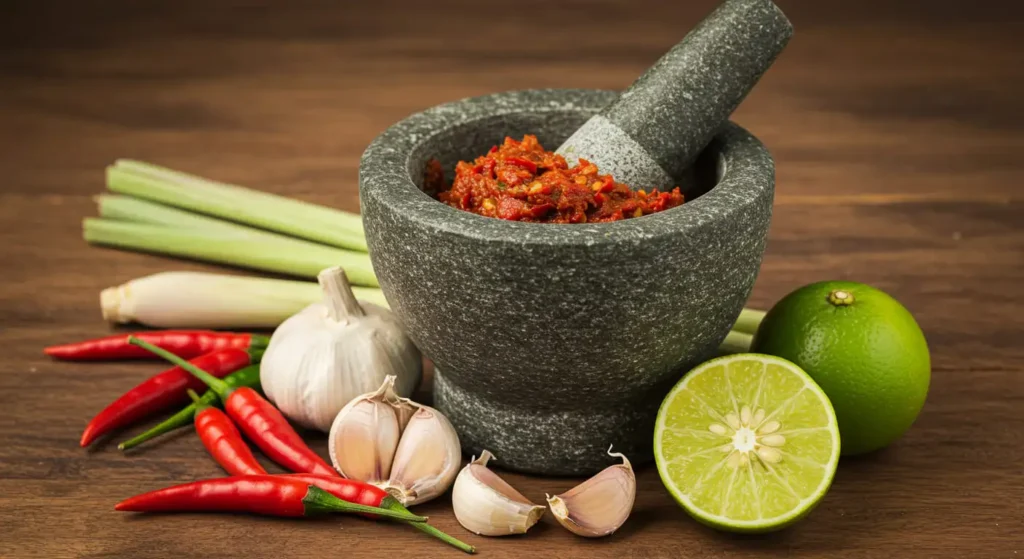
Thai chili’s bold, spicy taste is perfect for stir-fries, curries, marinades, and sauces. It’s great for both seasoned chefs and newcomers. In this article, we’ll show you how to use Thai chili in your cooking.
Table of Contents
Understanding Thai Chili: A Spicy Introduction
Thai chili is key to Thai food, known for its strong heat and unique taste. To get the most out of Thai dishes, knowing about Thai chili is important. It has different types and a Scoville rating that shows how hot it is.
The heat and taste of Thai chili come from capsaicin. This is what makes chili peppers hot. When cooking, knowing the Scoville rating helps make dishes just right.
What Makes Thai Chili Unique
Thai chili stands out because of its flavor, texture, and smell. It tastes bright and crisp, with a heat level that’s not too soft or too hard. Depending on the cooking method, its consistency ranges from crisp and firm to tender and yielding.
Common Varieties of Thai Chili
There are many types of Thai chili, each with its own special traits. Here are a few well-known ones:
- Bird’s eye chili: packs an explosive heat level with a sharp, vibrant flavor profile
- Bird’s eye chili: packs an explosive heat level with a sharp, vibrant flavor profile
- Prik kee noi: these tiny but potent peppers bring intense spiciness to traditional Asian dishes
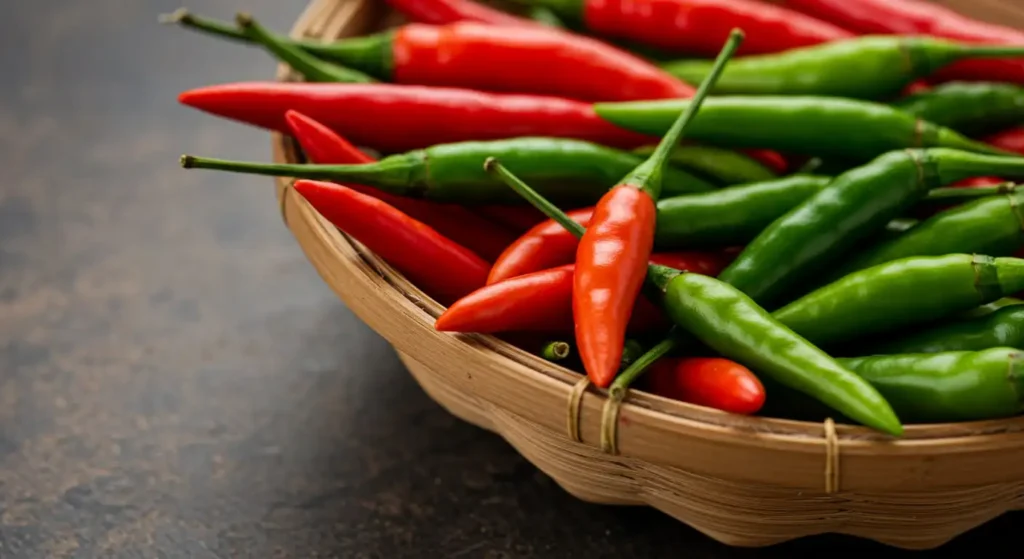
Essential Safety Tips for Handling Thai Chili Peppers
When working with Thai chili pepper, it’s key to be careful to avoid irritation and safety issues. Handling these peppers requires attention to prevent accidents. Wearing gloves is a must to prevent oils from touching your skin.
It’s also vital to avoid touching your face, like your eyes and mouth, after handling Thai chili pepper. The oils can cause severe irritation and burning. Always wash your hands well with soap and water after handling them.
- Handle Thai chili peppers in a well-ventilated area to prevent inhaling the fumes.
- Avoid ingesting Thai chili peppers without proper preparation and cooking.
- Keep Thai chili peppers out of reach of children and pets.
By following these essential safety tips, you can enjoy working with Thai-chili pepper while minimizing the risk of accidents and irritation. Always prioritize caution when handling Thai-chili peppers to ensure a safe and enjoyable cooking experience.
| Safety Tip | Description |
| Wear gloves | Prevent oils from coming into contact with skin |
| Avoid touching face | Prevent irritation and burning sensations |
| Wash hands thoroughly | Remove oils and prevent irritation |
The Perfect Thai Chili Paste Recipe
To make authentic Thai-chili paste, choose the right Thai-chili. This choice affects the paste’s flavor and heat. With the right ingredients, you can make a paste that makes your dishes better.
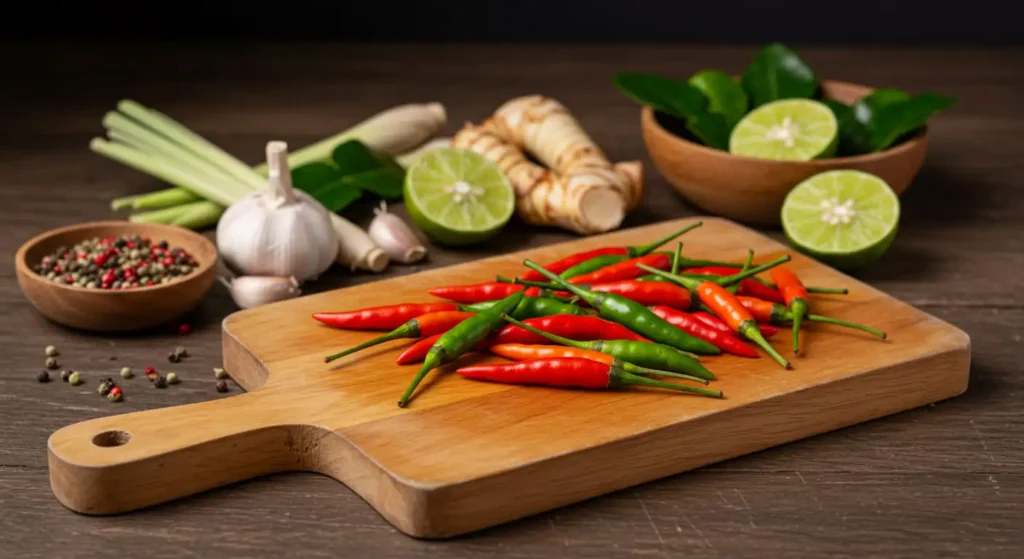
Required Ingredients
For a great Thai-chili paste, use fresh, quality ingredients. You’ll need Thai-chili peppers, garlic, lemongrass, and galangal. These give the paste its rich, complex taste.
Step-by-Step Preparation Guide
Preparing Thai-chili paste involves several steps. First, roast the Thai-chili peppers. Then, blend them with garlic, lemongrass, and galangal. Next, add fish sauce, lime juice, and palm sugar to balance the taste.
- Roast the Thai-chili peppers to bring out their natural sweetness.
- Blend the roasted peppers with garlic, lemongrass, and galangal.
- Add fish sauce, lime juice, and palm sugar to balance the flavor.
Storage and Shelf Life
After making the Thai-chili paste, store it well to keep its flavor and texture. Transfer the paste to a sealed container and refrigerate.It will last for weeks. You can also freeze it for later, making it easy to have on hand.
5 Powerful Ways to Use Thai Chili in Your Dishes
Thai-chilies pack a punch and bring an intense level of heat and flavor to any dish. Here are five powerful ways to incorporate them into your meals:
- Infused Oil: Heat neutral oil with sliced Thai-chilies for a spicy drizzle over stir-fries or noodles.
- Chili Paste (Nam Prik Pao): Blend roasted chilies with garlic, shrimp paste, and sugar for a flavorful base in curries or stir-fries.
- Pickled Chilies: Pickle Thai-chilies in vinegar and sugar to add tangy heat to dishes like Pad Thai or salads.
- Spicy Marinades: Mash or chop chilies into marinades for meats or tofu to add a fiery kick.
- Fresh Garnish: Thinly slice chilies to garnish soups, salads, or rice dishes for a fresh, spicy touch.
Incorporating Thai Chili in Traditional Asian Dishes
Thai-chili is a key ingredient in many Asian dishes. It adds flavor and heat. In Thai cooking, it’s used in tom yum soup and green curry.
To add Thai-chili, start by putting sliced or diced peppers in the pot. This will enhance the dish’s taste.
Some dishes that use Thai-chili include:
- Tom Yum Soup: a spicy and sour soup with Thai-chili, lemongrass, and protein.
- Green Curry: a creamy curry with Thai-chili, coconut milk, and protein.
- Pad Thai: a stir-fry with Thai-chili, noodles, and protein.
Remember, a little Thai-chili goes a long way.Begin with a modest portion and gradually increase according to your spice preference.The heat can quickly become too much.
You can mix Thai-chili with garlic and ginger. This makes a flavorful paste for many dishes.
Adding Thai-chili to your dishes brings new flavors and heat. It’s great for making spicy soups or flavorful stir-fries. Thai-chili makes your dishes more exciting and delicious.
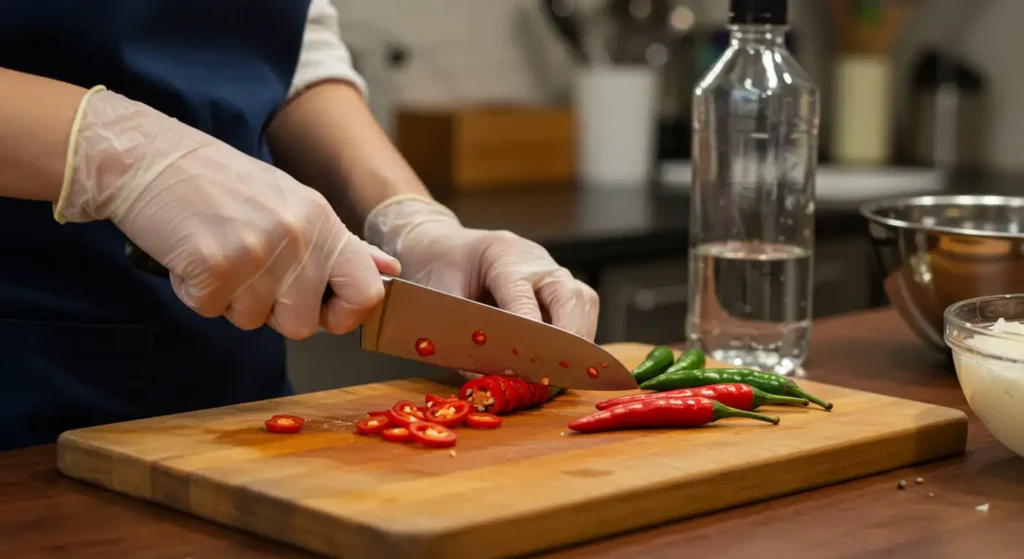
Preserving and Storing Thai Chili
To keep your Thai-chili pepper fresh, it’s key to store them right. You need a cool, dry spot, away from sunlight. This slows down how fast they spoil.
Using airtight containers is another smart move. They keep humidity in and moisture out. You can also wrap them in paper towels to soak up extra moisture. Freezing or dehydrating them is great for longer storage. Freezing keeps the flavor and heat, while dehydrating stops bacteria growth.
Here are some tips for preserving and storing Thai chili pepper:
- Store in a cool, dry place.
- Use airtight containers
- Freeze or dehydrate for longer-term storage
By following these tips, you can enjoy your Thai chili pepper longer. It adds flavor and heat to your meals. Good storage and preservation keep your chili pepper quality high, making your cooking better.

Common Mistakes to Avoid When Cooking with Thai Chili
Cooking with Thai-chili can be tricky. Knowing the Thai chili Scoville rating is key to avoiding mistakes. It’s important to think about the heat level and how you prepare it to get the right taste and texture.
Heat Control Errors
One big mistake is not controlling the heat when cooking with Thai-chili. This can make dishes too spicy or not spicy enough. To fix this, it’s vital to know the Thai chili Scoville rating and adjust the amount used.
Storage Mishaps
Storing Thai chili wrong can also cause problems. It should be kept in a cool, dry place to keep its flavor and heat. If not, the flavor and potency can fade.
Preparation Pitfalls
When cooking with Thai-chili, preparation mistakes can happen. Not removing the seeds and membranes can make the dish bitter. Knowing the Thai chili Scoville rating and being careful can help you avoid these mistakes. This way, you can make tasty and true-to-recipe dishes with Thai-chili.
Conclusion:
Thai-chili, chili Thai chili, and Thai chili pepper are key ingredients in cooking. They can make any dish exciting. Whether it’s traditional Thai food or new recipes, these peppers open up endless possibilities.
Now that you know how to use Thai-chili, you can become a pro at cooking with it. Try new things, mix flavors, and show off your cooking skills. Add these peppers to your dishes and watch them come to life.
Success in cooking with Thai-chili comes from knowing how hot they are and how to handle them. Find the right heat for you and use it wisely. This way, you’ll create dishes that everyone will love.
FAQs
What is unique about Thai-chili?
Thai-chili has a special taste that mixes heat, sweetness, and tanginess. It’s a key ingredient in many Asian dishes, like Thai and Southeast Asian foods.
What are the common varieties of Thai-chili?
You’ll find Bird’s Eye, Serrano, and Prik Kee Noo chilies often. They differ in size, color, and heat, but all have that unique Thai-chili taste.
How spicy is Thai-chili on the Scoville scale?
Thai-chili peppers range from 50,000 to 100,000 Scoville Heat Units. This makes them very spicy, perfect for adding heat to dishes.
How can I safely handle Thai-chili peppers?
To handle Thai-chili peppers safely, wear gloves to avoid skin irritation. Work in a well-ventilated area to prevent eye and respiratory irritation. After handling, wash your hands well with soap and water.
What is the perfect Thai-chili paste recipe?
The best Thai-chili paste recipe combines Thai-chili peppers, garlic, shallots, fish sauce, and lime juice. You might also add shrimp paste or palm sugar. The goal is to balance the flavors for a great paste.
How can I incorporate Thai-chili in traditional Asian dishes?
Thai-chili is essential in many Asian dishes, like curries and stir-fries. Start by adjusting the chili amount to your taste. Pair it with lemongrass, coconut milk, and fish sauce for the best flavor.
How can I use Thai-chili in modern fusion cuisine?
Use Thai-chili in modern dishes to add unique flavor and heat. Try it in burgers, tacos, or even desserts. Remember to adjust the amount based on the Scoville rating to balance the flavors.
How can I properly preserve and store Thai-chili peppers?
You can dry, pickle, or freeze Thai-chili peppers to keep them fresh. Drying is a common method for long-term storage. Pickling or freezing also helps preserve flavor and heat.
What are some common mistakes to avoid when cooking with Thai-chili?
Avoid not controlling the heat, improper storage, and not preparing chilies correctly. These mistakes can lead to bad texture or bitterness. Knowing the Scoville rating is key to avoiding these errors.
5 Powerful Ways to Use Thai Chili in Your Dishes
Course: DinnerCuisine: ThaiDifficulty: Medium5
servings10
minutes5
minutes100
kcalUnleash the power of Thai chili in your kitchen with these 5 incredible recipe ideas. Elevate your cooking and impress your guests with this versatile ingredient.
Ingredients
15 Thai chili peppers
3 cloves garlic
1 stalk lemongrass (chopped)
1-inch piece galangal (sliced)
1 tbsp fish sauce
1 tbsp lime juice
1 tsp palm sugar
Step By Step
- Roast the Thai chili peppers in a dry pan until slightly charred.
- Blend the roasted chilies with garlic, lemongrass, and galangal until smooth.
- Add fish sauce, lime juice, and palm sugar, mixing well to balance the flavors.
- Adjust seasoning to taste. If needed, add a little water for consistency.
- Store in an airtight container in the refrigerator for up to 2 weeks, or freeze for longer storage.
Notes
- Spice Level: This version is quite spicy! Reduce chilies if you prefer milder heat.
- Uses: Great as a base for curries, stir-fries, marinades, or dipping sauces.
- Storage Tip: For longer shelf life, freeze in small portions.



